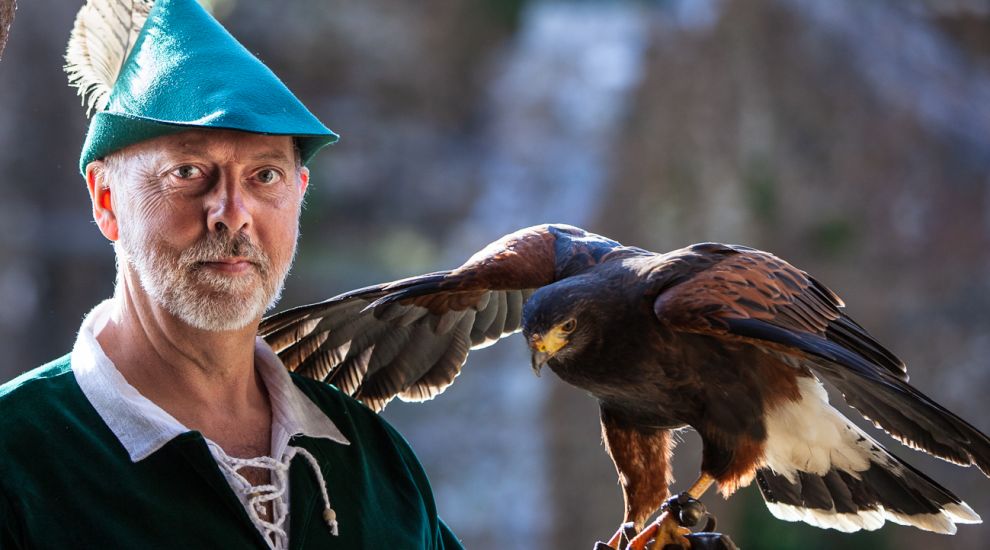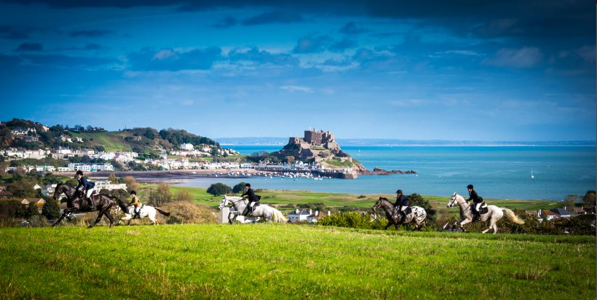


An islander is being sought to follow in the footsteps of ancient kings, and get to grips with birds, boozing, gorging and hoodwinking.
Mont Orgueil’s captivating Castle Falconer is getting ready to retire and Jersey Heritage are on the hunt for his successor.
The art of falconry, which comes with its own unique vocabulary, can be traced back as far as 2000BC, and became particularly important during the medieval period.
Bringing that era to life for many years at Gorey’s most prominent site has been Mike Entwistle, who is now taking flight into retirement.
“It was an activity central to medieval life and the Castle Falconer is an important costumed role at what is one of our most popular visitor sites,” Chris Addy, Jersey Heritage’s Sites Curator, explained.
“Mike has done a fantastic job for us and his replacement needs to be someone with a passion for local history and who enjoys being around animals, while also relishing the opportunity to share their knowledge and enthusiasm with our visitors.”

Pictured: The falconry displays take place twice a week between May and September at Mont Orgueil.
His replacement will not need any previous experience, as the successful candidate will be offered training ahead of the twice weekly demonstrations starting in May and lasting until September.
Richard Hall of Jersey Falconry will provide training on how to work with the hawk, Sovereign, and Mike will also share his expertise.
“This is a unique role that engages the historic skills of a falconer and an ability to capture the imagination of visitors to Mont Orgueil,” Mike said.
“I found it very rewarding as people always enjoyed my falconry demonstration and were excited to see a trained hawk flying free at the Castle.”
Anyone keen to learn more can read about the history of the role, and its unique vocabulary, below.
Click HERE to apply (deadline Friday 25 February).
Jersey Heritage laid out the history of falconry...
Falconry was well-established in the Middle and Far East by 2000BC. As well as being prized as hunting birds, falcons were apparently used by the Roman Emperor, Caesar, as a security measure to kill message-carrying pigeons.
Falconry is generally defined as the capturing of quarry using trained birds of prey.
By the 9th century, falconry was popular in Britain and throughout Europe. It was reputedly the favourite sport of ever English king, from Alfred the Great to George III, after which the more common use of guns for hunting signalled a decline in its popularity.
Despite the increasing importance of the gun, Henry VIII was known to be keen on hunting, hawking and falconry and was a great exponent of the arts, keeping over a 1,000 birds at the Royal Mews.
The value of trained birds could be high, depending on rarity and plumage, and the bigger the bird, the bigger the catch. In all cases, female birds are larger, generally more aggressive and commanded a higher price than male birds.
Tiercels (male falcons) were used to catch snipe and partridge; gyrfalcons (the royal bird) caught rook and heron; and goshawks would bring back hare, rabbis, pheasants and other large game birds. By comparison, the poorer man’s kestrels and sparrowhawks were used to only catch small songbirds and the odd mouse or vole.
So valued were some types of bird that they were occasionally used to pay ransom demands and as peace offerings between nations.
Although it was mainly a sport for the rich, many others relied on hunting with birds, often illegally, to feed their family. In the Middle Ages, a law of ownership was evolved by which the type of bird that could be kept depended on a man’s tatus, and rules to protest falcons were laid down, with severe punishment for destroying eggs and poaching in the wild.
These are the phrases a good falconer will need to know…
Hoodwink – blindfolding a hawk with a hood is a calming measure and makes it easier to remove the kill from its talons (ie the bird has been ‘hookwinked’)
Booze – as hawks were often trapped in Holland and needed to drink (‘boozen’) on their journey to England, ‘booze’ probably entered the language. When a bird drinks, it is ‘bowsing’.
Haggard (hag) – this was the name given to an older hawk caught in adult plumage after moulting in the wild, which was prized by falconers. But when applied to people, it is derogatory (hence, ‘hag’).
Gorge – allowing a bird to have its fill at a single meal.
Cadge – a rectangular frame for transporting birds carried by a man walking inside with straps over his shoulders, sometimes apparently taking up to 20 birds. Cadge- boys, or ‘cadgers’, as the men were known, tended to be old falconers, and often had to ask to be paid, hence ‘cadging for money’, and eventually the corruption ‘old codger’ was born.
Fed up – trained hawks are motivated by appetite and a bird that has ‘fed up’ (dined well) and just wants to rest and digest its food is unresponsive.
Callow – a nestling bird, now used to describe a person who is young or untested (‘a callow youth’).
Mantle piece – this may come from the action of ‘mantling’ by a bird, which it does to cover and protest its food.
Pictured top: Mike Entwistle in character with Sovereign.
Comments
Comments on this story express the views of the commentator only, not Bailiwick Publishing. We are unable to guarantee the accuracy of any of those comments.